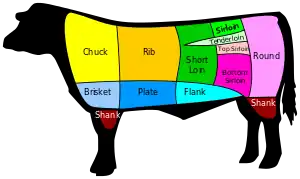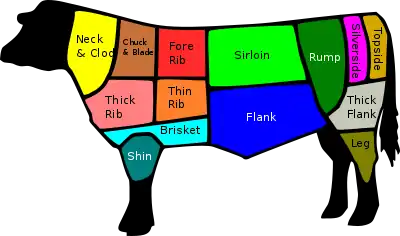Filet mignon
Filet mignon (/ˌfiːleɪ ˈmiːnjɒ̃/;[1] French: [filɛ miɲɔ̃]; lit. '"tender, delicate, or fine fillet"') is a cut of meat taken from the smaller end of the tenderloin, or psoas major of an animal carcass. In French it can refer to the tenderloin of several animals but is mostly used to refer to cuts of pork tenderloin.[2]
 Diagram of where filet mignon is butchered from. | |
| Type | Tenderloin |
|---|---|
The tenderloin runs along both sides of the spine, and is usually harvested as two long snake-shaped cuts of meat. The tenderloin is sometimes sold whole. Filet mignon is usually presented as a round cut taken from the thinner end of a piece of tenderloin. It is often the most tender and lean cut. Filet mignon often has a milder flavour than other cuts of meat and as such is often garnished with a sauce or wrapped with bacon.
Due to the small amount of filet mignon able to be butchered from each animal it is generally the most expensive cut of meat.
Usage
Europe

Across Europe filet mignon is used to refer to pork. However, in the UK, the term pork medallions is a more common for this cut of meat.
North America

Filet mignon refers to cuts from a beef tenderloin in North America.
Elsewhere, this cut of beef is called:
- Filet de bœuf (French)
- Fillet steak (English: UK, Ireland, South Africa)
- Eye fillet (English: Australia, New Zealand):
In the U.S., both the central and large end of the tenderloin are often sold as filet mignon in supermarkets and restaurants. The French terms for these cuts are tournedos (the smaller central portion), châteaubriand (the larger central portion), and biftek (cut from the large end known as the tête de filet (lit. "head of filet") in French).[3]
Porterhouse steaks and T-bone steaks are large cuts that include the fillet. The small medallion on one side of the bone is the fillet, and the long strip of meat on the other side of the bone is the strip steak—in Commonwealth of Nations usage, only the strip steak is called the porterhouse.
Preparation
Filet mignon may be cut into 1- to 2-inch (2.5 to 5 cm) thick portions, then grilled and served as-is. One also may find filet mignon in stores already cut into portions and wrapped with bacon. High heat is the usual method for cooking the filet mignon, either grilling, pan frying, broiling, or roasting.
Bacon is often used in cooking filet mignon because of the low levels of fat found in the cut (see barding), as fillets have low levels of marbling, or intramuscular fat. Bacon is wrapped around the fillet and pinned closed with a wooden toothpick. This adds flavor and keeps the fillet from drying out during the cooking process.
Traditional cooking calls for the filet mignon to be seared on each side using intense heat for a short time and then transferred to a lower heat to cook the meat all the way through.
See also
- Pork tenderloin
- Beef tenderloin
 Food portal
Food portal
References
- "filet mignon". Oxford Dictionaries. Oxford University Press. Retrieved 2015-11-13.
- Hamlyn (2009). Larousse Gastronomique. UK: Hamlyn. p. 989. ISBN 978-0600620426.
- Child J (1961). Mastering the Art of French Cooking.


